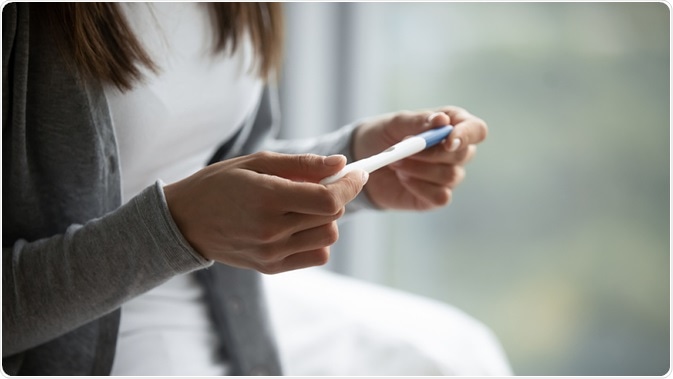Infertility refers to when a couple has failed to become pregnant after one year of regular (defined as two to three times a week) and unprotected intercourse. Infertility is a common problem, affecting between 10 and 15% of couples in the U.K and U.S.
Within one year of regular unprotected sex, 84% of couples have conceived, while 92% have conceived after two years and 93% after three years. The chances of a couple conceiving in the fourth year of trying after three years of being unsuccessful are 25% or less.

Image Credit: fizkes / Shutterstock
Infertility can be caused by a number of factors, which may involve one or both partners. In one-third of cases, infertility involves the female; in one-third, the problem lies with the man and in the remainder of cases, both partners have infertility problems or neither partner has problems and the infertility is classed as “unexplained.”
Common causes of infertility in women include endometriosis, irregular ovulation, and obstruction of the fallopian tubes. Among men, the most common cause is sperm disorders.
Couples trying to conceive are advised to have regular intercourse during the periods of the menstrual cycle where ovulation is most likely, which is during the 6 days before ovulation, particularly the three days before ovulation. Ovulation most commonly occurs halfway through the menstrual cycle, at around day 14.
Among women with regular periods, measuring the morning basal body temperature can help to determine when ovulation is taking place. A lower temperature suggests ovulation is due, while an increase of 0.5˚C or more is an indicator that ovulation has just occurred. A less disruptive alternative is using a luteinizing hormone (LH) prediction test kit to identify the LH surge, which occurs halfway through the menstrual cycle when ovulation occurs.
If these measures do not lead to pregnancy after one year of trying, the couple may undergo a fertility assessment, which begins with an evaluation of the couple’s patient history, physical examinations, and counseling. Women are checked for ovulatory and tubal dysfunction and men are checked for sperm disorders.
The strategy used to treat infertility depends on what is causing it, the partners’ ages, how long the couple has been unable to conceive, and personal preferences. Fortunately, there are various safe and effective methods for helping a couple overcome infertility and these are described below.
The three main strategies for treating infertility include the following:
- Drugs to assist fertility
- Surgery
- Assisted conception
Drugs to assist fertility
- Clomiphene: This drug is used to stimulate ovulation in women with irregular or absent ovulation.
- Tamoxifen: An alternative to clomiphene, this drug also promotes ovulation.
- Metformin: This medication is particularly helpful for women who have polycystic ovarian syndrome.
- Gonadotropins: These are drugs that promote ovulation in women and may also improve male fertility.
- Gonadotropin-releasing hormone and dopamine agonist: These are also prescribed to improve ovulation in women.
None of the above drugs should be prescribed to women with unexplained infertility since there is no evidence that the drugs are effective in these cases.
Surgical procedures
Fallopian tube surgery
Some cases of infertility are caused by obstruction or scarring in the fallopian tubes, which can occur as a result of pelvic inflammatory disease. This can require surgery to repair the fallopian tubes by breaking up the scar tissue and freeing up the tubes so that eggs can move through them. This surgery is associated with a risk of ectopic pregnancy.
Laparoscopic surgery
This may be used to treat cases of endometriosis, to remove or destroy cysts or to remove sub-mucosal fibroids. In cases of polycystic ovary syndrome, laparoscopic ovarian drilling may be used if medication has failed to induce ovulation. Part of the ovary is destroyed using either heat or a laser.
Correction of epididymal blockage
The coil-like structure in the testicles is referred to as the epididymis, which stores and transports sperm. If this becomes obstructed, sperm is not properly ejaculated. This blockage can be corrected with surgery.
Surgical extraction of sperm
In some cases, sperm may need to be surgically extracted. This may be an option for men who have an obstruction that stops the release of sperm in cases of injury or infection; for men with a congenital absence of the vas deferens or for men who have had a vasectomy or unsuccessful vasectomy reversal. Men are advised on the same day as the procedure about the quality of any sperm collected. Enough sperm are usually obtained for several cycles of treatment and then frozen and stored for later use.
Assisted conception
Intrauterine insemination (IUI)
Sperm is placed in the womb using a fine plastic tube that enters the womb through the cervix. The procedure is scheduled to coincide with ovulation. The woman may be given hormones that stimulate ovulation in order to increase the chance of conception. The procedure can cause period-like cramps but is otherwise painless. Provided that a man’s sperm and a woman’s fallopian tubes are normal, the success rate of this procedure is around 15% for each treatment.
In-vitro fertilization (IVF)
In IVF, a woman’s egg is fertilized outside of the body. Medication is used to stimulate more ovulation than usual and her eggs are then removed and fertilized in a laboratory. The embryo is then placed back inside the womb. Intracytoplasmic sperm injection may also be performed, which involves injecting a single sperm directly into the egg’s cytoplasm, thereby allowing more control over which sperm fertilizes which egg.
The success rate of IVF is around 30% for each cycle of treatment among women aged under 35, but this success rate decreases with increasing age.
How in vitro fertilization (IVF) works - Nassim Assefi and Brian A. Levine
Egg and sperm donation
If either partner has a fertility problem, they may be able to receive eggs or sperm from a donor, which are then used in an IVF procedure.
Further Reading
Last Updated: Mar 1, 2021